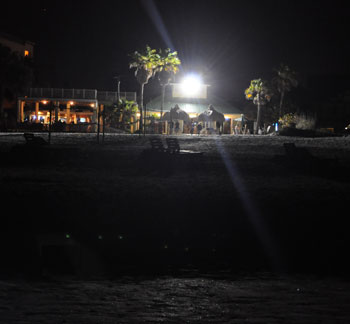Commercial fishing
Every year hundreds of thousands of sea turtle are captured accidentally in fisheries. The amount of captured, injured and killed sea turtles globally is stunning. 150,000 turtles of all species killed in shrimp trawls, more than 200,000 loggerheads and 50,000 leatherbacks captured, injured or killed by longlines, and large numbers of all species drowned in gill nets.
Marine debris
Over 1 million marine animals are killed every year because of plastic in the ocean. More than 80% of this plastic is from land from, from our beaches and even from our streets. The result is that sea turtles eat these peaces of plastic thinking they are food. Some can even get stuck around their necks and they will and up dying.

Artificial lights
Sea turtles refer to the sun in the day and the stars at night to swim from a place or another. When they see an artificial light they will most likely think it is the sun or the stars, especially for little hatchlings.

Coastal Armoring
People owning houses near the sea or the city usually build coastal armoring like walls or rock revetments between the sand and the closest houses to protect their properties from natural erosion. The problem is that this urbanization is going onto the nesting areas of sea turtles.

Beach erosion
Since the beach erodes there is less sand so usually more sand is brought to the beach. This technique is preferred to coastal armoring but if it is done incorrectly it can have as bad or worst results.

Vehicles on beaches
A lot of people may not realize but there are some vehicles on the beach. Sea turtles are maybe fast in the water but on land they are very slow. If a comes at a sea turtle and it won’t have time to get out the way. If the vehicle is going fast it has a high risk of dying.
Marine Pollution
Marine pollution can have a big impact on sea turtles. A new research says a disease now killing many sea turtles (fibropapillomas) may be linked to pollution in the oceans and in near-shore waters. When pollution enters the water, it kills aquatic plant and animal life that is often food for sea turtles.
Oil spills
Oil spills can have a serious impact on sea turtles but also the food they eat. Oil spills are a big problem for sea turtles and they affect them the same way as marine pollution.

Climate change
Because sea turtles use both marine and terrestrial habits during their life cycles, the affects of climate change are likely to have a devastating impact on these endangered species. For example the food they eat ( other sea mammals or fish) might not live in the same areas as them anymore because they are not adapted anymore.
Natural threats
Sea turtles have already a lot of threats from humans but they also have some in their own natural habitat. When sea turtles hatch there are often birds such as seagulls just waiting to eat them and there might be raccoons or even foxes passing by. Even if they do make it to the ocean there are still sea birds and other predators waiting for them there as well.
Sources
https://conserveturtles.org/information-sea-turtles-threats-sea-turtles/